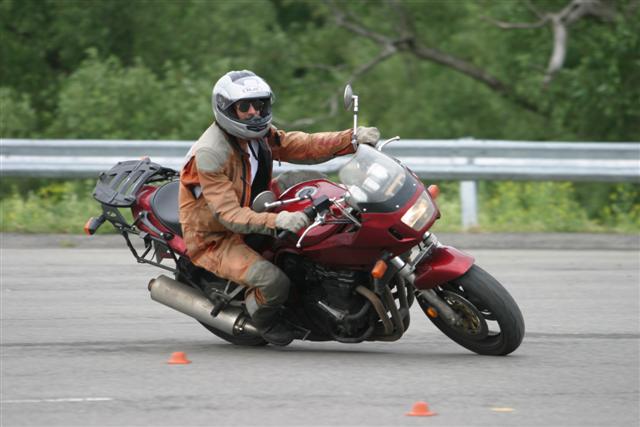Traction Management for Motorcyclists -
and what happens when you blow it
Frequently asked question:Perhaps you could explain high-siding and low-siding. I hit my head too many times to adequately understand the difference — except that high-siding hurts more.
If the crash results from a loss of traction, it's a low-side. A common example is going too fast around a turn, a tire slides, the bike goes down more or less gently on its side (the side closer to the ground, the low side), motorcycle and rider slide across the pavement. Generally nothing really bad happens, unless you slide off the cliff, or into a tree, or the 18-wheeler in the oncoming lane runs over you. That leather or textile suit, the one with the armor in the shoulders and knees and elbows, will prevent the loss of skin. Of course, if you're in the "helmets kill" camp and wear a 3/4 helmet or less, you can lose a lot of your face.
Grabbing the front brake in an emergency situation can do the same thing. If the front tire skids, it slides out to one side or the other. If you catch it quickly enough you can regain traction by releasing the brake, but it happens fast. The usual result is that the motorcycle and rider go down. Similar consequences can result as for the cornering low-side, with the added problem that there's something in front of you that you wanted to avoid — otherwise you wouldn't have grabbed the front brake. Since a motorcycle stops more quickly on the tires than on the side, you now have a much greater chance of hitting it, in addition to the fact that you can swerve a lot better on the tires than on the side. Don't grab the front brake!
The high-side, by contrast, results from a loss of traction by the rear wheel, followed by recovery of traction. For street riders, as opposed to racers, it generally arises in a maximum braking situation. In such a situation, when you want all the braking you can get, it's easy to exceed the maximum, that is, to slide one or the other of the tires. What do you do? If the front tire slides, you release the front brake. Quickly! Quite intuitive. But if the rear tire slides, you should stay on the brake and slide it to a stop, contrary to one's instincts.
Here's why. Suppose you're driving down the road at 50 and you step hard on the rear brake, locking up the rear tire. It slides. It won't stay in a straight line right behind the front tire, but will fishtail from side to side. Assuming that the road is flat and you're steering straight, it just swishes around behind you. No problem, easy to control, so easy in fact that the previous version of the MSF's beginner course had an exercise devoted to controlling rear-wheel skids. Just keep it locked and slide it to a stop.
But suppose that you do what most people instinctively do when they hear the squeal of the skidding tire — release the brake. If you're lucky and the rear tire is directly behind the front, nothing happens. The rear tire starts to roll again and all is well. But if you're unlucky and the rear tire is off to one side — say to the rider's right — then the situation is thus: At the instant of brake release, the front tire is pointed straight down the road and is rolling straight down the road. The rear tire is sliding straight down the road, but it's to the rider's right, and so pointed to his left. Then you release the brake. The rear tire regains traction and starts going the way it's heading, to the left. This is rapid, even violent. "Ejection seat" is not an exaggerated description. It snaps around to the left and keeps going, and the back of the bike gets further and further to the left, until the whole bike gets sideways. And of course the tires slow down at the bottom while the top of the motorcycle keeps going, so it flicks the rider off, AHEAD of the motorcycle, and then the bike cartwheels after the rider.
Now this is bad. The rider and motorcycle are flying through the air, and it can happen that the bike lands on the rider. But you could get lucky, and you hit the ground ahead of where the bike hits the ground, so both of you slide down the road. Who slows down faster? You do. So then your own motorcycle runs over you. Followed, of course, by that 18-wheeler.
Bad. Now how'd we get into this situation? We made two mistakes. First we locked the rear tire. That in itself isn't enough, isn't even very bad, though it does increase your stopping distance somewhat. But then we released it. The high-side is caused when the tire regains traction (unless you're lucky enough that it's aligned with the front when you release it). So to avoid the high-side, don't do both of those things. First, don't lock the rear brake. Now that's easy to say and hard to do since, as I discuss here, there's not a lot of traction at the rear tire. So it's easy to lock the rear tire. If you do, keep it locked and slide it to a stop. You won't high-side unless you release the rear brake.
If you watch races you'll see high-sides frequently. They're almost always caused in a slightly different manner. A rider gets hard on the gas as he comes out of a turn, and the rear tire breaks loose, spinning. When it hooks up again, if the bike isn't straight, the back end will go out just like the above. Again, the cause is the loss of traction at the rear, followed by the resumption of traction.
